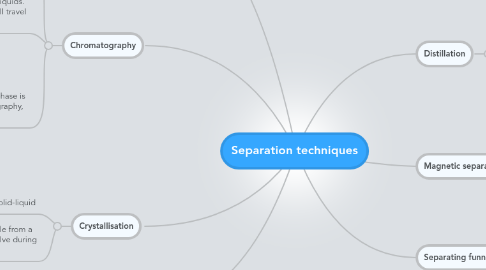Separation techniques
von kelly teo


1. Chromatography
1.1. liquid-liquid
1.2. Used to separated soluble liquids. The more soluble liquids will travel further.
1.2.1. If solution is more attracted to stationary phase, then it would travel a shorter distance
1.2.2. If solution is more attracted to mobile phase (solvent), then it would "follow" the solvent and travel a longer distance.
1.3. Column chromatography: stationary phase is like the paper in the paper chromatography, mobile phase will be like the solvent.
1.3.1. Order of polarity: petrol ether, beta carotene < chlorophyll < acetone < paper, silica gel < water
1.3.2. Order: cotton wool, stationary phase, sand, mixture, mobile phase (in order), to allow the mobile phase to "flush through".
